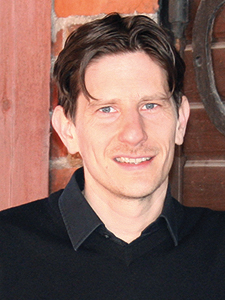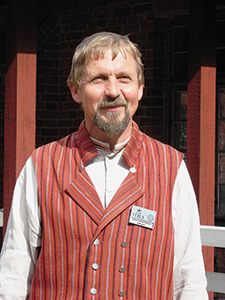It feels like time has stood still in the dimly lit machine hall of the historic Verla mill. The old machines seem to be waiting silently to be started up again.

Ville Majuri
“The same kind of groundwood and board mills operated in all countries in the northern coniferous forest zone. This mill largely survives in its original form – the neighbouring rapids were not strong enough to power larger-scale production, so it was never expanded,” explains Ville Majuri, Director of the Verla Mill Museum.
Verla’s very first groundwood mill was founded in 1872, but the wooden structures were destroyed in a fire just a few years later. The ruined building was replaced by a new wooden groundwood mill, with a new board mill added alongside. When fire destroyed the drying loft, architect Eduard Dippell designed the new brick buildings in 1893. Verla mill produced its last sheet of board in summer 1964 and was opened for public visits as an industrial heritage site in 1972. UNESCO nominated the Verla groundwood and board mill for its World Heritage List in 1996 in recognition of the well-preserved mill surroundings, village and workers’ housing. Today the site is owned and run by UPM.
A history of recycling know-how
In the centre of the mill, there were eight wet-lap machines producing 70 x 100 cm board sheets. Thinner qualities were made for the packaging industry, while thicker qualities were made for applications such as book covers and picture mount boards. The annual output was some 2,000 tonnes of board, plus the same amount of groundwood too. Verla was well known for its high-quality output, which was exported to as many as 30 countries.

Jussi Lemminkäinen
Spruce was the main raw material used for making mechanical pulp. Peeled bark waste was incinerated to generate heat in the drying loft. Damaged and unsuitable board sheets were reground into mechanical pulp, but the workers could also use them for insulating their homes. All materials were recycled until they reached the very end of their lifecycle.
“The worn clothing from wet-lap machines was sought after because it was reused as children’s clothes, and the old stones used in the grinder machines were cut into four pieces and used in the foundations of the workers’ housing,” the mill tour guide Jussi Lemminkäinen explains.
Worker education and health care
The main building that overlooks the rapids in the village was the residence of the mill owner, Gottlieb Kreidl, who ruled both the mill and village with a firm, patriarchal hand. Though authoritative, Kreidl was a reformist dedicated to improving the workers’ social welfare and health care.
“The mill paid for the workers’ medical treatment and medicines, and there was even a sickness and burial fund, as well as a pension fund for them,” explains Lemminkäinen.
Kreidl was also eager to educate the people of Verla. In 1890, the mill founded a primary school for children, which was taken over by local authorities in 1922.
In its peak years, the mill had some 150 workers, roughly 40% of whom were women. Men were responsible for the more physical and dangerous tasks like peeling and grinding the wood and maintaining the machines. Women were in charge of operating the cardboard machines and the drying loft and separating the board sheets.
“Although women’s wages were about 60% of what men earned, they still made more money in one month than the entire yearly income of women working on farms,” Lemminkäinen adds.
Verla wakes up in summer
“In the summer, we have some 40,000 visitors touring the site. In a good year, we have as many as 22,000 visitors on our guided mill tours,” notes Lemminkäinen.
The old machine hall also preserves a fascinating slice of Finnish industrial history. Karhula and Tampella – the very first heavy industry and paper machine manufacturers in Finland – built the grinding machines, as well as some of the wet-lap machines. The board sheets were lifted from the machine hall by an early lift model manufactured by the world-renowned elevator company KONE. Several belts and straps on the wet-lap machine were made by the Nokia company – a company that went on to become a founding member of the Nokia Corporation, nowadays a famous name in the information technology and communications sector.
The Verla Mill Museum is open from the beginning of May until the end of September.
Petra Niemi
